第一部分:SQUID基础
Squid代理服务的基本配置:
| http_port 3128 #设置监听的IP与端口号 |
常用的ACL列表类型:
| src 源地址 |
第二部分:准备测试环境
物理机为Win10系统,网关192.168.1.1,自动获取IP地址上网。
三台虚拟机设置如下:

1、RHEL2 作为外网服务器,桥接到物理机无线网卡上,设置固定IP为 192.168.1.200
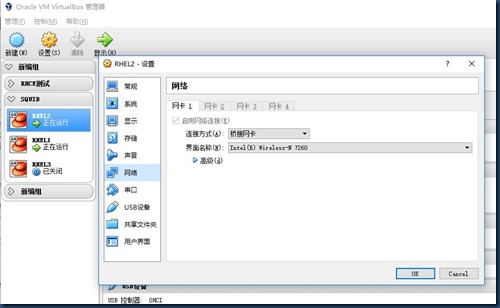
#hostnamectl set-hostname rhel2.rusky.com
#nmcli connection add type ethernet con-name enp0s3 ifname enp0s3 autoconnect yes
#nmcli connection modify enp0s3 ipv4.addresses 192.168.1.200/24 ipv4.gateway 192.168.1.1 ipv4.dns 211.139.29.170 ipv4.method manual connection.autoconnect yes
2、RHEL1 作为内网的一台SQUID代理服务器,部属squid服务,同时添加两块网卡,一块插到内网“交换机 VirtualBox Host-Only Network #6”,另外一块连接到内网(桥接到物理机无线网卡上),
如下图所示:
虚拟网卡 VirtualBox Host-Only Network #6 作为内网的交换机(IP为192.168.100.100)。
#hostnamectl set-hostname rhel1.rusky.com
# nmcli connection down enp0s3 --设置内网IP
# nmcli connection modify enp0s3 ipv4.addresses 192.168.100.1/24 ipv4.gateway 192.168.100.100 ipv4.dns 192.168.100.1 ipv4.method manual connection.autoconnect yes
# nmcli connection down enp0s8 --设置外网IP
# nmcli connection modify enp0s8 ipv4.addresses 192.168.1.201/24 ipv4.gateway 192.168.1.1 ipv4.dns 211.139.29.170 ipv4.method manual connection.autoconnect yes
3、RHEL3作为内网的另外一台客户端服务器,插到内网“交换机 VirtualBox Host-Only Network #6”,用于测试。
主机名:rhel3.rusky.com IP:192.168.100.3
=================================
第三部分:在外网服务器RHEL2上架设测试网站,在RHEL1上配置SQUID代理,然后从RHEL3通过代理来访问RHEL2上架设的测试网站。之后完成一些简单的测试。
1、在RHEL2上架设测试网站
#yum install httpd -y
#firewall-cmd --permanent --add-service=http
#firewall-cmd --reload
#echo lxjtest > /var/www/html/index.html
#systemctl restart httpd
2、在RHEL1上配置squid服务器
#yum install -y squid
#firewall-cmd --permanent --add-port=3128/tcp
#firewall-cmd --reload
#systemctl restart squid
最简单的代理服务器,安装完成后,啥也不用修改,默认就可以使用了。内网其它客户机把RHEL1当做跳板来访问外网RHEL2上架设的网站。
3、在客户机RHEL3上访问测试
直接Ping RHEL2的IP 192.168.1.200 是不通的。
浏览器未设置代理服务器之前也无法访问RHEL2 192.168.1.200 上的网站,设置代理服务器为192.168.100.1:3128之后就可以访问了。(这就是正向代理)
SQUID初始化:
#vi /etc/squid/squid.conf
cache_dir ufs /var/spool/squid 100 16 256 #取消注释,再执行squid -z才会建立,如果不启用,则只使用内存,生产环境中一定要取消注释该行。
#squid -k parse #检测配置文件
#systemctl stop squid
#squid -z #重建缓存,在/var/spool/squid下生成很多缓存目录。
| [root@rhel1 squid]# pwd |
#systemctl start squid
#tail -f /var/log/squid/access.log 查看访问日志
#tail -f /var/log/squid/cache.log 查看cache日志
测试一:通过SQUID服务来阻止某一网段或固定IP的客户端访问测试网站。
在RHEL1上修改SQUID配置文件,增加两行:
# vi /etc/squid/squid.conf
| # Example rule allowing access from your local networks. acl SSL_ports port 443 # # Deny CONNECT to other than secure SSL ports |
添加完上面的两行后,重启SQUID服务。
在RHEL3客户机上访问测试不通,提示被拒绝。如果把上面配置文件第二行修改为allow,则访问正常。这个设置规则可以参照基础部分的列表类型来进行设置。
但是在其它客户端上通过代理访问测试网站正常。
测试二:通过一个列表文件来限制访问
创建一个列表文件:
# vi /etc/squid/ipblock.list --名称随便写,把需要限制的IP地址加进来
192.168.100.3
192.168.200/24
#vi /etc/squid/squid.conf --修改主配置文件,添加里面两行内容
| # Example rule allowing access from your local networks. acl SSL_ports port 443 # |
重启squid服务
# systemctl restart squid.service
通过客户端访问测试,可以看到我们配置的限制列表文件已生效了。
生产环境中经常通过限制域名的方式来限制用户对外网的访问,比如,新建一个/etc/squid/domainblock.list文件,添加如下内容:
.taobao.com
.qq.com
.jd.com
.toutiao.com
等等来限制员工对外网的访问。主配置文件添加下面的两行:
acl domainblock dstdomain "/etc/squid/domainblock.list"
http_access deny domainblock
从基础内容部分的列表类型可以看出,我们还可以限制用户在指定的时间范围内对外网的访问。SQUID确实功能挺强大。
测试三:ACL列表的另外一种写法
# vi /etc/squid/squid.conf
acl allowclienttest src 192.168.100.3 192.168.100.123 --可以添加多个IP,空格分隔
http_access allow allowclienttest
http_access deny !allowclienttest --加!符号表示拒绝非allowclienttest指定的IP客户端访问。
测试四:通过时间范围控制对外网的访问
只允许指定客户端在指定时间范围内访问,否则全部拒绝。
# vi /etc/squid/squid.conf
acl allowclienttest src 192.168.100.111 192.168.100.10 192.168.100.123
acl allowtimetest time mtwhf 9:00-17:00 --指定周一至周五(周六a,周天s),9点至17点的时间范围
http_access allow allowclienttest allowtimetest
http_access deny all --拒绝所有
实验五、SQUID安全机制:通过htpasswd工具生成认证
其实就是通过apache httpd自带的htpasswd工具创建一个存有用户名和密码的认证文件。之后,配置squid启动密码认证机制 auth_param basic program,用自己的basic_ncsa_auth命令去调认证文件。即当你在访问代理服务时,需要输入管理员给你指定的用户名和密码才能访问。如果不这么做,则任何用户只要知道squid服务器的IP和端口就可以通过代理服务器上网,这样也不安全。
在RHEL1上
安装httpd-tool工具
# yum install httpd-tools.x86_64
查看认证程序命令位置
| [root@rhel1 ~]# rpm -ql squid | grep ncsa /usr/lib64/squid/basic_ncsa_auth /usr/share/man/man8/basic_ncsa_auth.8.gz |
创建隐藏的用户密码文件userlist,并添加用户testusersquid1
| [root@rhel1 ~]# htpasswd -c /etc/squid/.userlist testusersquid1 #-c 创建 New password: Re-type new password: Adding password for user testusersquid1 |
添加testusersquid2用户
| [root@rhel1 ~]# htpasswd /etc/squid/.userlist testusersquid2 #添加用户testusersquid2 (不用加-c参数,否则会把前边加的用户覆盖了)。如果加参数m,则使用MD5加密,有时候客户端不支持,所以一般不加m参数。 |
查看认证文件:
| [root@rhel1 ~]# cat /etc/squid/.userlist |
修改主配置文件,加入下面的内容:
| #vim /etc/squid/squid.conf auth_param basic program /usr/lib64/squid/basic_ncsa_auth /etc/squid/.userlist #启动密码认证机制,用basic_ncsa_auth命令去调用userlist文件。 auth_param basic children 100 auth_param basic realm Welcome to lxjtest.rusky.com web server auth_param basic credentialsttl 2 hours acl auth_user proxy_auth REQUIRED http_access allow auth_user |
#当用户在访问代理访问时,需要输入userlist文件中的配置的用户名和密码才能访问。
测试六:透明代理
前面使用的代理方式上网都很麻烦,客户端浏览器必须自己配置代理服务器的IP地址和端口号才能上网。而透明代理则通过在服务器上配置策略,强制用户走代理服务器上网,所以客户端浏览器不需要做任何设置。实现原理:配置防火墙端口转发策略来限制用户上网时自动转发到代理服务器的3128端口。
修改主配置文件:
#vim /etc/squid/squid.conf
#http_port 3128 #这一行是普通的正向代理,把这行注释掉,如果不注释会和下面冲突
http_port 192.168.100.1:3128 transparent #透明代理加上这行。任何用户访问192.168.100.1的3128端口,则自动走透明代理服务。
添加防火墙策略:
如果采用iptables做防火墙,需要打开路由转发
| #iptables -t nat -A PREROUTING -i eth0 -s 192.168.100.0/24 -p tcp --dport 80 -j REDIRECT --to-ports 3128 #iptables -t nat -A PREROUTING -i eth0 -s 192.168.100.0/24 -p tcp --dport 443 -j REDIRECT --to-ports 3128 |
如果采用firewalld做防火墙
| #firewall-cmd --permanent --add-rich-rule="rule family="ipv4" source address="192.168.100.0/24" forward-port port="80" protocol="tcp" to-port="3128" to-addr="192.168.100.1"" |
#firewall-cmd –reload 重新加载防火墙策略
#内网用户192.168.100.0/24网段的客户机如果上外网,则自动转向代理服务器。
建议采用图形化的方法添加富规则
#firewall-config
#family选择ipv4
#element选择forward-port 规则选择来源tcp/80转发到另一个ip为192.168.100.1的3128端口
#source选择192.168.100.0/24
测试七:反向代理
反射代理原理:假设 www.cnblogs.com(IP为192.168.1.201) 网站把试验中的RHEL1作为反向代理服务器,两块网卡,一块连内网,另外一块连外网(供用户通过外网访问),上面安装SQUID服务,未部属Apache httpd。然后他们公司内网的4台服务器(192.168.100.2~4)共享同一存储,每台服务器上都部属Apache httpd 服务。当有用户访问www.cnblogs.com(192.168.1.201)网站时,RHEL1上的反向代理服务会从内网的4服务器中的其中一台上把网页反向发送给用户,内网的4个网站由于共享存储,所以访问到任何一台服务器上时,网页内容都是一致的。反向代理服务器RHEL1还起到一个“负载均衡”的作用。
在RHEL1上安装squid,并修改主配置文件如下:
| #vim /etc/squid/squid.conf cache_peer 192.168.100.2 parent 80 0 originserver weight=5 max-conn=30 |
如果有多台服务器,就添加多条记录。weight 是权重,比如其中一台服务器的性能比较好,可以把这台服务器的 weight 值设置高一些。max-conn是最大连接数,当连接数达到最大值时,自动“负载”到另外一台服务器。如果其中某一台服务器上的httpd服务停止了,反向代理服务器也会自动到访问其它内网服务器。
# firewall-cmd --add-port=80/tcp –permanent --还要添加防火墙策略,允许80端口。虽然RHEL1服务器并未部属httpd服务,但是它要反向代理内网的httpd服务,所以得开放80端口。







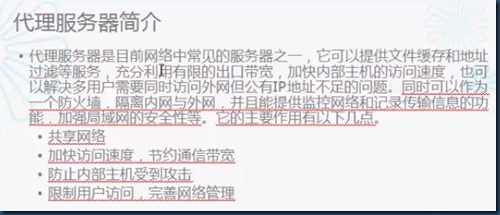
![clip_image001[7] clip_image001[7]](https://images2017.cnblogs.com/blog/418785/201711/418785-20171112160243138-653053349.png)
![clip_image001[9] clip_image001[9]](https://images2017.cnblogs.com/blog/418785/201711/418785-20171112160244356-596916366.png)
![clip_image001[11] clip_image001[11]](https://images2017.cnblogs.com/blog/418785/201711/418785-20171112160245591-1933473366.png)
![clip_image001[15] clip_image001[15]](https://images2017.cnblogs.com/blog/418785/201711/418785-20171112160249903-491020430.png)
![clip_image001[17] clip_image001[17]](https://images2017.cnblogs.com/blog/418785/201711/418785-20171112160251200-1556794988.png)
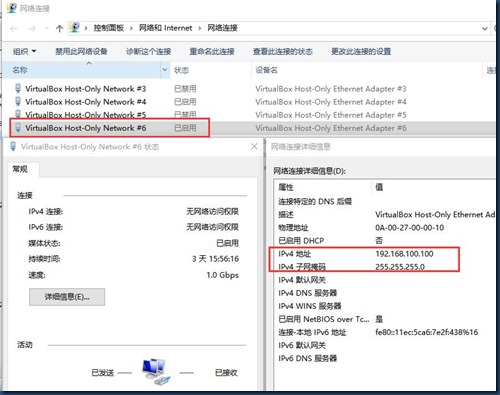
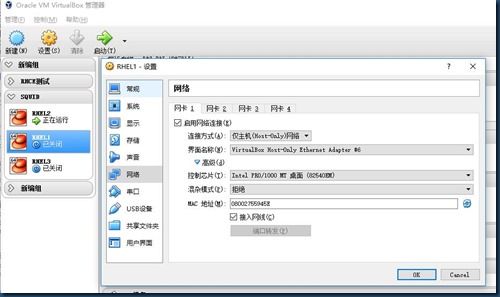
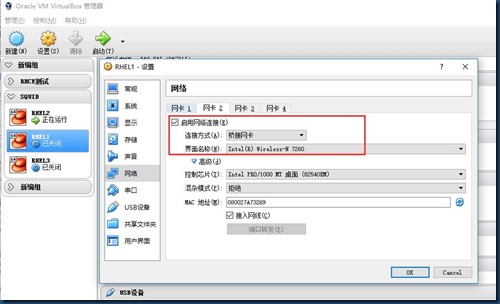
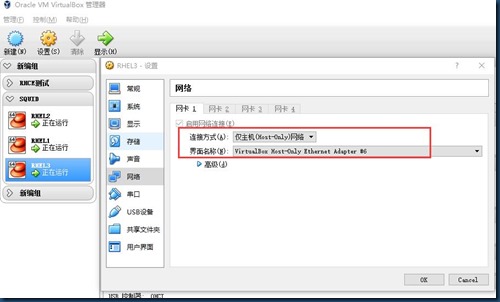
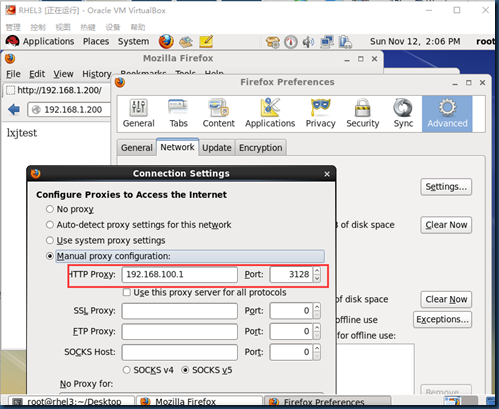
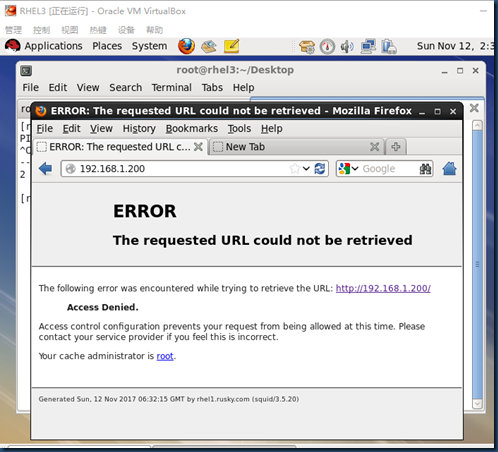
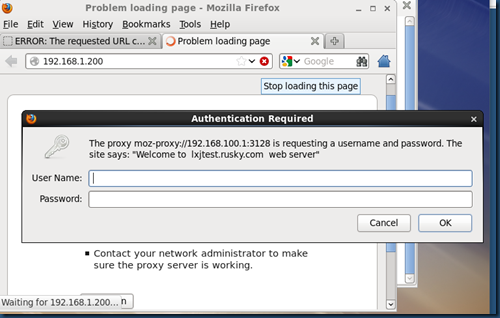
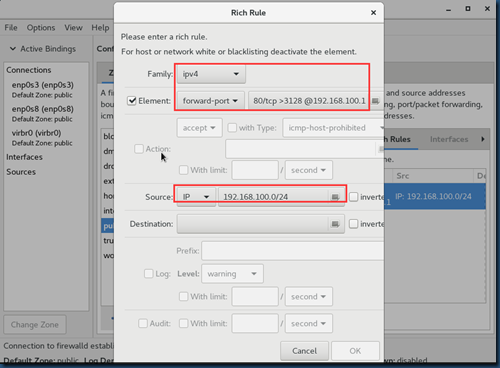
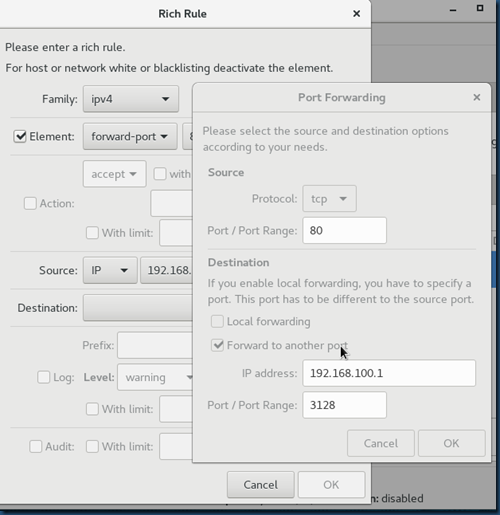
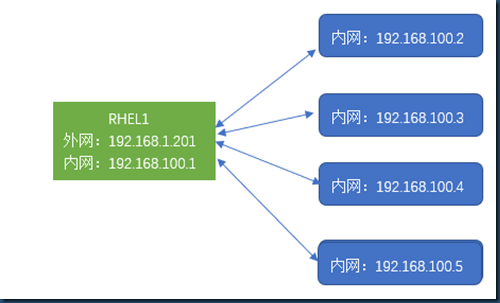















 250
250











 被折叠的 条评论
为什么被折叠?
被折叠的 条评论
为什么被折叠?








